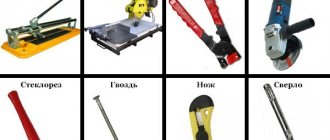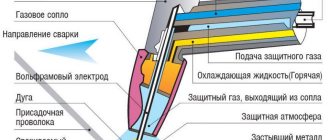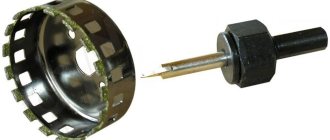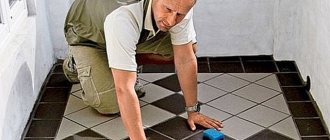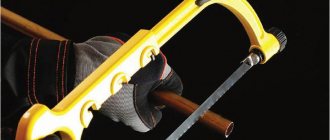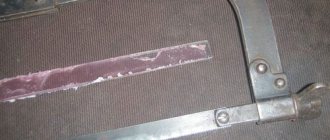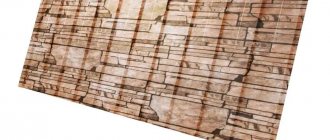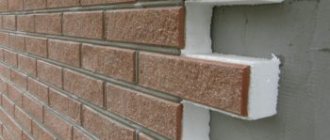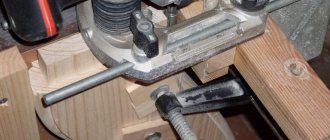Facing work with tiles and porcelain stoneware involves the use of various types of devices, which are presented in a wide range in construction stores today. Among them, tools for cutting factory blanks are mandatory. Let's look at how to cut tiles with a manual tile cutter. Let’s take a look at the experts’ recommendations for selecting and maintaining devices so that they last for a long time.
Cutting tiles with a manual tile cutter Source plitkahelp.com
Manual tile cutter
When working with facing material or laying sidewalk paths, it often becomes necessary to cut individual elements to exact dimensions. A similar problem is solved using a manual tile cutter.
What is the choice based on?
To decide which manual tile cutter is best to choose, it is recommended to imagine how often it is planned to be used, what working volumes will have to be mastered, and what building materials will have to be cut.
If you purchase a tool for repair work performed on your own, you should pay attention to manual modifications. They cost reasonable, cut tiles one and a half centimeters thick, and do not make noise during operation.
In cases where large volumes of finishing work are to be done, and ideal cutting quality is required, especially when facing tiles from different materials, including stone, are used, then it is best to immediately purchase an electric tile cutter with a drive. This type of tool is characterized by greater productivity; it cuts thick tiles within one minute, making an even cut.
Hand tools for professionals and amateurs
Tile cutters are deliberately divided into such groups. The amateur version is not very expensive, but cannot withstand prolonged use. There is no additional functionality, or its quality leaves much to be desired. This tool is used for single repairs.
A professional-level tool will cost you quite a lot, but the price difference will be compensated by high-quality assembly, good components, and accurate design calculations. Cutting is performed with better quality, and the service life of the tool increases.
For convenient use, the kit includes rulers, stop elements, squares and other accessories. This type of tile cutter is popular among finishing workers.
What criteria are used to select a tool for cutting tiles?
Before you start using a manual tile cutter, you should choose it correctly, taking into account all the nuances and distinctive features. There are certain points that you must pay attention to:
- full compliance with the stated requirements. The strength of the cutting part is selected taking into account the material to be cut; the maximum parameters for the depth and length of cutting are determined based on the parameters of the tile used in the repair;
- high-quality assembly. The tile cutter is visually inspected for defects, and the lever is moved to make sure there is no play. When the lever is pressed, the guides must remain level and not bend;
- Possibility of cutting at an angle. The function is useful; with its help, the tile material in the corner areas is adjusted as accurately as possible. The working platform is easy to adjust, the installation does not get lost after fixation, and there is no play;
- availability of spare parts and consumables that periodically need replacement.
In addition, there is a possibility of breakdowns, and it would not be superfluous to clarify in which stores the components for your tile cutter are purchased, where the repair shops are located, if it is not possible to fix the problem on your own.
Preparing the tool for work
The most important thing at this stage is to check the integrity of the structure and the performance of the functional organs. All chips and irregularities during the work process can affect the quality of the result. Separately, fastening devices are checked - for example, flange nuts and guide clamps. It is also necessary to calculate the cutting parameters, which will depend on the size of the workpiece and the characteristics of the tool itself. A model with a small grip will cope well with small-format segments, but for thick and large elements you will need a version with a powerful rail base. And in the second case there will be some operating nuances. For example, how to use the Dexter 730 mm manual tile cutter, which is considered one of the most productive in its class? It is very important for him to ensure reliable fastening of the workpiece, and it is better to cut large parts into small segments. So, when processing a porcelain stoneware slab with a thickness of about 14-16 mm, it is advisable to cut a 30 cm piece in two approaches in equal parts.
Classification of manual tile cutters
The tile cutter is designed for manual straight cutting (for non-round holes of various diameters - using a circular “ballerina” cutter) of ceramic non-porcelain tiles up to 15 mm thick. Convenient for quick cutting, silent, does not require electricity costs, and its operating principle is similar to a regular glass cutter.
According to their design and operating principle, tile cutters are divided into:
- manual roller tile cutter - this type of manual tile cutter is used for cutting a piece of wall or floor tiles at a right angle, or in other words, at an arbitrary angle. The tile is fixed on the rubberized base of the frame; not under uniform pressure of the lever, the cutting element (roller) makes a cut along the marking along another break.
- manual bearing tile cutter - the movement of the carriage with the cutting disk is carried out along the guide rails by a bearing mechanism. The radial bearings installed in professional models ensure a much longer service life of the tool, high cutting accuracy and the quality of the tile edges.
The choice of the necessary tool directly depends on the expected volume of tiles to be processed. For each specific tile cutter model, the characteristics indicate the maximum size of the processed tile and the range of its possible thickness (from 4 to 20 mm). There is no need to take a tile cutter with a bed that is too short - the universal length of the platform will allow you to process either wall or floor tiles, in addition, if you need to position them for a longer diagonal cut.
It is not the manufacturer of the construction tile cutter that plays an important role. The most famous, well-established brands that guarantee the quality of their tools: Germans Boada, SA, RUBI, Matrix, First, Sigma.
Criterias of choice
- Frame strength. The higher this indicator, the longer the service life of the tile cutter. itself must be made of durable steel , so that the tiles will not split during the work process.
- The presence of a long handle makes cutting porcelain stoneware easy.
- The length of the tool directly affects its versatility. Thus, long models are suitable for cutting floor and wall tiles. Naturally, the longest tile cutters are quite expensive.
- Smooth running is another important factor that affects the quality of cutting. To evaluate this indicator, it is enough to perform a test cut, as a result of which the line should be smooth.
- Reliable fixation ensures cutting safety. To do this, it must be possible to fix the base on a table or other surface.
- A goniometer is an important element of any tile cutter. Thanks to it, you can fix the material at different angles, which makes the tool universal.
Tile cutter device
The device of a manual tile cutter
On the fixed tile, a cutting line is drawn along which the tile cutter wheel is drawn. Next, the lever is lowered and the material breaks along the marked line. This work takes no more than 1 minute.
Rules for using a manual tile cutter.
Before using the tile cutter, it is worth dripping oil onto the guide frame and wheel to apply the mark. Make sure the wheel is securely fastened. It should not move to the sides, otherwise you will get a crooked cut line. When the cutting wheel wears out, it is worth replacing it by purchasing a similar one at a hardware store.
Processing tile edges with nippers
Before you begin the process, you should first try making a few experimental cuts of the desired curve. If you are unable to make the necessary cut with a manual tile cutter, you should use an automatic one, or make several cuts and break off the tiles in small pieces using nippers.
Cutting tiles with a glass cutter
How to cut tiles using a glass cutter and a nail
As a last resort, a nail and a glass cutter are used for these purposes. Using a glass cutter, a notch is made on the front side of the material, the tile is laid on the nail with the back side so that the line made and the nail coincide, and then with your fingers you press on both halves of the slab.
- You can also use a jigsaw with a carbide blade on it. However, it will take much longer to complete the work this way. But none of the above tools will do the job better than the tile cutter itself.
Angle grinder (grinder) - multifunctional tool
Cutting tiles with a manual or electric tile cutter requires the purchase of these tools, which is not always justified in the case of household work. In addition, after tiling work, you will no longer be able to use these tools anywhere.
For a home craftsman, a good solution may be to use an angle grinder (grinder). But working with this tool has its own specifics.
First, you need to decide on the size of the angle grinder itself. The best option for cutting tiles would be a grinder with a 125 mm disc. It is convenient to hold and manipulate.
Angle grinder with 125 mm disc
It is better not to use grinders with a disc diameter of 230 mm for such work. The tool is very bulky, which makes manipulation difficult and significantly degrades the quality of the cut. It is permissible to use an angle grinder with a disc diameter of 180 and 150 mm, but only if cutting thick tiles or porcelain stoneware.
A grinder can cut all types of ceramic tiles - wall, floor and even porcelain tiles. Without any problems, you can make straight cuts, at an angle and some curved ones.
To simplify the work, you can consider purchasing a special attachment for an angle grinder - “Slider”.
Angle grinder with Slider attachment.
Let's take a step-by-step look at how to cut ceramic tiles with a grinder without chipping:
To cut ceramic wall or floor tiles, you must use a solid diamond blade for dry cutting.
Disc for cutting ceramic tiles.
It is imperative to work in a protective mask and goggles, since dry cutting of tiles creates a large amount of dust. Due to the dust, this cutting method is not always suitable for an apartment. In the absence of proper experience, the cutting lines are not clean and accurate. It is best to make several practice cuts.
Step 1. Marking.
The location of the cut is marked in the standard way: lines are drawn on the plane with a pencil, marker or chalk.
Step 2. Fixation.
The tiles are fixed in a stationary state using clamps.
Step 3. Cut.
The incision is made towards you, the disc is positioned perpendicular to the surface. Sometimes the grinder moves back and forth to reduce the heating temperature. To prevent chips from forming on the front surface, the angle grinder must be tilted slightly to the side. If the cutting angle is less than 900, then chips will not form.
Step 4. Revision.
Abrasive processing of edges when operating an angle grinder is necessary. If you used an abrasive disc with a special “Slider” attachment, you will have to sand the edge less, since the number of chips is minimized. Grinding the edge is done with the same grinder used for cutting, or with emery cloth attached to a block.
How to cut porcelain tiles with a grinder:
Next, we’ll look at how to cut porcelain tiles at home. To cut porcelain stoneware, it is necessary to choose continuous diamond-coated wheels designed for wet operation. When choosing a wheel, pay attention to the maximum permissible rotation speed; it must correspond to the rotation speed of the angle grinder.
Disc for cutting porcelain tiles.
Cutting porcelain tiles must be carried out with a constant supply of a small amount of water. Otherwise, the coating on the disk will not last long and it will quickly cease to perform its functions. Therefore, before work, you need to prepare a plastic bottle of water by first piercing a hole in the bottle cap.
Step 1. Marking.
It is best to mark porcelain tiles with a marker.
Step 2. Fixation.
Stone granite must be secured with clamps on a reliable, not shaky base
Step 3. Res.
By moving towards you, you need to apply a thin groove on the surface of the porcelain stoneware. Then the cut line must be moistened with water and again make a shallow cut, moving towards you. These operations must be repeated until the tiles are completely cut.
Step 4. Revision.
At the bottom of the cut, the tile may have roughness. To refine it, you need to turn it over to the reverse side, clamp it with a clamp and use an angle grinder and a diamond disk to slightly grind the edge.
Pros and cons of the manual model
The undoubted advantages of a manual tile cutter include:
- independence from the power grid. This device can also be used where there is no electricity or it is temporarily turned off. When working in wet areas - for example, when tiling a bathroom, swimming pool, sauna - the ability to cut tiles directly at the workplace, without going into another room with a working outlet, is very important;
- no temperature restrictions.
- Injuries when using the device are practically excluded. Maximum – damage due to accidental fall of the device on the leg or pinching of a finger;
- mobility. The products are small, even the largest options, weigh up to 1...3 kg, are easily transported and do not require special conditions of transportation and storage.
The main disadvantages are:
- the difficulty of cutting small strips along the edge of the tile. If the distance from the edge to the cut is less than 3 cm, only an experienced cutter using hand tools will be able to make an even cut;
- problems when working with tiles of non-standard sizes. Both very small and very large specimens are difficult, sometimes impossible, to cut;
- the need to exert physical effort to make the cut.
Other possible shortcomings depend rather on the specific model chosen:
- tile fracture due to excessive depreciation;
- excessive force resulting from insufficient lever length;
- insufficient size of the working area;
- uneven movement of the carriage;
- difficulty in replacing the roller (cutter) or its insufficient quality.
These points (except for the last one, it is not always possible to check the quality of the cutter in a store) should be paid attention to when purchasing.
Which tile cutter to use for cutting
There are two types of tile cutters: these devices are electrical and mechanical. The first type is suitable for industry or construction work. Manual models are used for cutting tiles at home.
There are three types of household tile cutters:
- Roller. The device consists of a handle and a cutting roller. It is used as a separate tool or used in conjunction with a saw station.
- On bearings. This option is used when it is necessary to cut durable ceramic tiles with a thickness of more than 16 mm.
- Mechanical. Thanks to the presence of a rigid carriage, the device can be used to perform precise cutting.
Important! No model will be able to cut a strip from the very edge if the width required is less than 10 mm. In this case, the worker will need to use wire cutters.
While working with the tool, the master should not be distracted by anything
Electric tile cutter - a tool for professionals
An electric tile cutter belongs to the class of professional equipment, so it is expensive. Its purchase is justified if the master is professionally engaged in finishing work on laying tiles. An electric tile cutter is a full-fledged machine on which you can cut any non-metallic material: ceramic tiles, porcelain tiles, natural stone, concrete, porcelain.
The machine performs a large number of operations: straight cuts, cuts diagonally, saws at any angle, makes chamfers up to 45 degrees, notches, grooves, technological cuts. The cutting line turns out perfectly even, smooth, without chips or chips. The electric machine does not make curved cuts.
The design of an electric tile cutter is complex: there is a frame, an electric unit with a diamond-coated carbide disc, a fixation system, and a water tray. There are two types of electric tile cutter models.
The most common are models in which the disk is attached to the bottom of the body and extends halfway out of the base. The second half is located below and is constantly in contact with the water poured into the pan. In electric tile cutters of this type, the cutting disc is rigidly fixed, and to make a cut it is necessary to move the tile.
Electric tile cutter with bottom blade.
Less common are glass cutters in which the disk is located on top on a special guide and moves along the working surface on which the tile lies. In such models, water is supplied directly to the cutting disc.
Electric tile cutter with top blade.
Let's take a step-by-step look at how to make tile cuts with an electric tile cutter:
Step 1. Preparation.
Before cutting, pour the required amount of water into the tile cutter tray.
Step 2. Marking.
You can mark cutting lines directly on the machine, where there is a system of rulers and protractors with clear and precise divisions. Therefore, the tiles are immediately laid on the machine.
Step 3. Cut.
Turn on the tile cutter and make sure that water flows around the cutting blade. Then bring the tile to the cutting disc at the required location and, pushing the tile through the disc, make a cut.
Step 4. Revision.
As a rule, finishing abrasive finishing is not required - the edges are even, smooth, without chips. But if the edge of the tile is rough, smooth it out using sandpaper.
Tool limitations
It is believed that a manual device of this type can only cut tiles up to 15...16 cm thick. At the same time, roller devices provide minimal cutting force, a rigid carriage provides greater impact, and only the most powerful bearing models can handle panels with a thickness of 15...16 mm.
Manual models are of little use for tiles and porcelain tiles with a relief surface. If the cutter does not reach the bottom of all the recesses, the layer of glaze will not be cut evenly. Therefore, a smooth fault cannot be expected.
With respect to porcelain stoneware, the limitation on thickness may be more serious: even bearing tile cutters do not always cope with panels with a thickness of 15...16 mm.
Features of using nippers for cutting tiles
This is a pliers version of the tile cutter, which is characterized by its small size and the ability to make shaped non-standard recesses. A typical example of this type of tool is the STAYER 3352 with a 200mm plastic jaw. The design of the model allows you to create neat cuts in workpieces made of tiles, ceramics and glass. How to use the manual tile cutter STAYER 200 mm? The principle of operation is similar to that of conventional wire cutters. The workpiece is secured in a vice or pressed against a stationary structure with your free hand, after which you need to grab the target section of the tile with your other hand and break it.
Recommendations to help you work with the tool
Even if you have your own experience working with a tile cutter, it’s worth taking on board the advice of the experts, which will make the process of using the tool easier:
- If the device is needed for one-time use, then it is worth purchasing an inexpensive model. For repeated use, it is best to buy a professional device.
- Cutting must be carried out in a working area whose length is greater than the diagonal of the finishing material.
- Before operating the device, you need to drop a couple of drops of machine oil onto the surface of the roller - this will improve the quality of the cut.
- It is necessary to work the tool smoothly in order to obtain an even, lower and neat break.
Tool structure
Manual models of tile cutters are distinguished by an optimized design with a lever, which carries out the cutting. The functional part is based on a metal platform installed on a flat surface. This is a kind of bed that ensures the stability of the work process.
The platform contains guide rails, a spring block for securely fastening the workpiece and grips. The cutting is performed by a roller, the movement of which is controlled by the user himself. That is, the quality of the result will largely depend on the skill of the performer. This is how the standard design works for standard operations, but how to use a manual roller tile cutter if you need to get complex shaped cutting?
Firstly, an oblique cut can be obtained in the simplest budget models with a rotating functional part. It is enough to initially tilt the working part relative to the platform and make the necessary cut. Secondly, ballerina models should be used exclusively for holes. In a way, this is an integrated drill, which also operates along given guides, but most often has an electric drive.
Carving technique with a manual tile cutter
Correctly cutting tiles with a tile cutter is much easier if you follow the following rules:
- Step #1. The tile must be secured and cut in a straight line along the future fault.
- Step #2. Lower the lever and break the tile into two parts.
The process is very simple and will not take more than a minute to cut one tile. But, it is necessary to take into account some nuances in order to make high-quality cuts and use tiles in construction with a clear conscience:
- To ensure a straight cut, mark cutting lines on the tile using a felt-tip pen. These cutting lines then need to be aligned with the wheel to apply the cut.
- When cutting, you need to hold the tile in place with one hand, and the handle with the wheel with the other hand.
- The handle of the tile cutter must be raised so that the wheel touches the surface of the tile from its upper part. Then move the handle towards you.
- Light pressure is enough. Do not overdo it so as not to break the wheel. The wheel should only make one pass.
- The line is drawn. Now we need to split the tiles efficiently and evenly. To do this, the wings are installed at the base of the handle at the level of the lower third of the tile. It is recommended to cover the wings with adhesive tape so that there are no marks on the finished tile.
To break a tile efficiently, professionals hold it in the desired position, press the handle a little with their thumbs, and then hit the handle a little with the palm of their right hand.
Tools
0 votes
+
Vote for!
—
Vote against!
High-quality surface tiling with ceramic tiles often involves the use of a tile cutter, which will help adjust the tile to the desired size. A tile cutter is the simplest and highest quality way to cut tiles: the operations are silent and eliminate the appearance of dust, and most importantly, they do not require professional training, so they can be performed even by an inexperienced user at home.
Content:
- Cutting tiles as part of tiling work
- Cutting tiles with an electric tile cutter
- How to cut tiles with a manual stationary tile cutter
- How to cut with a roller tile cutter
- How to use a tile cutter
- Cutting curved edges and oblique lines
Cutting tiles as part of tiling work
Laying ceramic tiles on the surface of a floor or wall is only rarely done without cutting them; more often, the master keeps a tile cutter at the ready, which he can use at any time during the tiling work.
So, our article is especially for those who are currently engaged or are just planning to tile surfaces with ceramic tiles, but have not yet decided on the choice of the most suitable tile cutter model and do not know the correct cutting technology.
It is known that glazed ceramic tiles are made of fired clay, covered with a layer of glaze on top. The technology for producing ceramic tiles is very simple: the clay is given a certain shape and dried to fix the volume. After applying the glaze, the product is fired in a kiln, due to which it acquires special strength, durability and a beautiful aesthetic appearance. In its finished form, as you yourself know, the tile is not subject to deformation or bending, although it is very fragile and chips easily.
All these properties and characteristics of the tile become the basis for choosing a specific method for cutting it. Let us dwell in more detail on the main methods of cutting ceramic tiles and tell you how to use a tile cutter at home to perform small amounts of work.
Cutting tiles with an electric tile cutter
There is no doubt that an electric tile cutter with a diamond blade is the highest quality and highly productive way to cut tiles, stone and porcelain stoneware of any hardness, shape and even thickness, and its use guarantees a completely straight and clean cut with slightly rounded and smooth edges , as opposed to sharp , which are formed as a result of using a simple tile cutter. Armed with an electric tile cutter, additionally equipped with nippers, you will be able to produce shaped cutouts of impeccable quality and tile pieces less than 5 mm.
Another undeniable advantage of this type of equipment is the cleanliness of the work process due to the instrument being equipped with a tray of water, into which dust and tiny particles of tiles are collected at the time of operation.
Regardless of the design features of the electric tile cutter, the cutting technology is the same: traditionally, the machine consists of a platform, a diamond-coated disk attached to it, and a tray with water, which is supplied to the knife during operation, thereby abundantly wetting it. Due to this, the amount of dust released is noticeably reduced, the service life of the diamond disc is increased, and the tile itself does not crack.
The speed of cutting tiles is comparable to the speed of cutting a log with a regular saw, but in this case you have to move the tile under the disk, and not the knife under the tile.
The force of pressure on the tile is determined by the density of the tile and the material from which the knife blade is made. It should be remembered that at the moment when the knife blade barely touches the tile being processed, the pressure should be minimal; as the blade moves through the tile, it increases and decreases again towards the end of the operation. When cutting, the tile should be well secured to the table, this will help avoid vibration and reliably protect the blade from jamming in the central area of the tile.
It should be noted that experts advise changing the water in the pan as often as possible, since together with the tile chips that fall into it, it is fed to the knife, and this can lead to serious damage to the blade.
A win-win option would be to press the tile on both sides with your hands at the same time, since if the tile tilts to one side, the edges of the cut will turn out uneven and with fragments, or the disk will completely tighten the tile, then throwing it to the side.
Since working with an electric tile cutter is fraught with danger, it is recommended to wear protective glasses and headphones against strong noise.
The saw blade can withstand a thousand cuts in wet cutting conditions. Periodically, a blade clogged with ceramic particles requires cleaning. This can be done by sawing through a worn sand brick mold or making cuts in a ceramic tile grinding stone. You can choose another method - remove the blade, unfold it and rotate it in the opposite direction. And only if the blade wear is great, you can replace it.
The question of the advisability of purchasing a professional electric tile cutter, practice and experience for working with it are extremely important, each user decides individually. At the same time, I would like to note that it is very effective for large volumes of work, and its only drawback is its high price.
How to cut tiles with a manual stationary tile cutter
A manual stationary tile cutter is the most common tool for high-quality cutting of tiles and porcelain stoneware among professionals and those who decide to carry out repairs themselves.
The manual tile cutter, the photo of which is presented below, includes a frame, a carriage with a cutting wheel and, of course, a handle.
Many people ask the question: “How to use a manual tile cutter?”
So, the technology for working with such a tool is incredibly simple: first, the future cut is marked with a pencil on the surface of the tile. Then the tile is placed on the surface of the frame so that the markings coincide with the direction of movement of the cutting wheel, and the cut is made under slight pressure. At this moment, it is important to feel the force of pressure so as not to crush the tile and at the same time make a cut groove of such a depth that would be sufficient for subsequent breaking along this cut.
Remember, the cutting motion should only be done once, otherwise the cutting edge may end up uneven.
Next, the handle of the tile cutter must be switched to the active (for breaking) state and with a quick, confident movement, break the tile along the fresh cut. An experienced master will do this with one clap of the palm, correctly calculating the force. It should be noted that the parts to be cut must be at least 10 mm in width, otherwise high-quality cutting will not be possible.
When working with a manual stationary tile cutter, it is important to pay attention to the fixation and condition of the cutting roller: it should rotate easily and be level. The movement of the carriage with the cutting roller must be smooth, excluding jerking; for these purposes it is equipped with a bearing. The device bed must be clean and level, and the handle must be free of mechanical damage.
To make it easier to break the tile, specialists soak it in water before cutting, and a drop of machine oil applied to the line of the intended cut will greatly simplify cutting.
A video from YouTube will clearly show how to use a tile cutter.
Using a manual stationary tile cutter to cut durable and thick ceramics is effective for medium-sized workloads. In general, working on an instrument of this type with the existing skills is not particularly difficult.
How to cut with a roller tile cutter
A roller tile cutter is the most primitive and not very convenient way of cutting tiles and not very hard and dense ceramics.
The cutting process itself involves drawing a marking line on the surface of the tile using a soft pencil. Then you should place the tiles on a board or flat plywood and make one cut. To do this, apply even pressure on the tile cutter, making a deep groove from one edge of the tile to the other.
To carefully divide the tile into two parts, just place it on the nails and apply a little pressure.
It should be noted that the glass cutter, whose instructions describe all the features of the process of cutting ceramic tiles, is suitable exclusively for cutting piece material.
How to use a tile cutter - nippers
Cutting with a manual tile cutter requires a small amount of work and simple cuts. This inexpensive, small-sized device will allow you to complete a given amount of work without much effort at home.
Cutting begins with a traditional marking, along which a cutting wheel mounted on tongs is carried out. The tile cutter has a slightly larger circle than a regular glass cutter, allowing you to make a deeper cut in ceramic tiles. To break the edge of the tile, you should use tongs. Place the wide plate of the tongs forming a slight angle on the front side of the tile, and place the central part along the bend line above the groove made. By carefully squeezing the ceramic piece with tongs, excess parts break off.
Such devices are certainly better than a glass cutter, but cutting thin strips with their help is extremely difficult.
Cutting curved edges and oblique lines
To perform such complex cutting, it is necessary to mark the shape of the cutout on the slab - an angle or circle, for example, for the exit of a pipe or for fastening tiles to a wall protrusion area. Then, using tongs or an electric machine, you should carefully cut out all the excess parts and, using pliers or pliers, “gnaw off” a piece of the tile, gradually approaching the edge of the boundary line.
To get a perfectly even, smooth end, experts recommend using a needle file or coarse sandpaper.
Finally, it should be noted that all recommendations apply to cutting glazed ceramic tiles only and are not suitable for porcelain, stone or unglazed ceramics.
Tip: Will you be trying to cut tiles for the first time? Then don't risk it and buy a few more tiles. Only after acquiring certain skills will you be able to quickly and easily make smooth, beautiful cuts without involving third-party specialists.
Features of cutting using a rack tile cutter
Before using a rack tile cutter, you should become more familiar with the design features of the tool. If we are talking about a professional model, then during operation you can remove the cutting device and check its sharpness. This tile cutter has a base and tubular runners along which the cutting element made of hard alloy will move. You should not go through the same cutting area several times, as the result will not be positive. In order to get high-quality tiles after cutting, you should be able to break the material correctly. There is a tubercle on the base, with the help of which the edges of the ceramic product are raised above the surface. Thanks to this addition, you can break the product by placing it on the ledge. Among other things, the ceramic can be broken using a T-shaped foot, which is located in front of the roller. This heel is installed in the center of the cut so that when the lever is pressed, it presses on the blade. With this tile cutter you can cut through the material diagonally.
Design and principle of operation of tile cutters
There are many models of tile cutters on the construction tools market. All their diversity, according to the type of energy due to which work is performed, is divided into two main types:
- mechanical;
- electric.
Using a mechanical type, a straight or figured (curvilinear) cut of the tile is made and holes are created in it. In this case, the thickness of the processed material is limited to 16 mm. Electric tile cutters are highly productive: they are capable of cutting tile material more than 16 mm thick.
The principle of cutting tiles with mechanical and electrical tools is different. But both types of equipment models are used both in everyday life and in professional activities in accordance with their functionality.
Mechanical Tool Design
Mechanical tools are divided into hand-held and stationary (desktop) models. There are two types of manual tile cutters:
- in the form of wire cutters, the design of which is shown in the photo below;
- in the form of a roller cutter having the device shown in the photograph below.
The design of manual models is very simple, but with their help you can only work with thin tile material.
Stationary products are represented by a large number of different modifications. But in all cases, the desktop tile cutter device has the following structural elements:
- a carriage with a cutting roller and a handle moving along guides;
- base (also called a platform, table or bed);
- a lever used to break the cut tile;
- tile fixing tabs.
The guides are fixed to the posts. All the parts examined are shown in detail in the following photograph.
Some models have measuring rulers, which allows cutting without preliminary marking. If the mechanism has additional devices, such as ballerinas, then you can use them to cut holes of different diameters.
With hand cutters and stationary models, work is performed according to the following principle:
- a roller makes a cut in the material being cut;
- The tiles are broken along the cut line.
Using a tile cutter/nippers, small pieces are cut off from the tiles. This tool can only be used to work around the edges.
Device of electric tile cutters
Electric tile cutters are similar in design to a circular saw. They are divided into two types:
- manual models;
- machine (stationary) electrical equipment.
The main components of any model are:
- electric motor;
- a head with a diamond disk attached to it;
- lever;
- power button.
The electric motor of network electrical equipment can be single-phase (operating on a voltage of 220 V) or three-phase (designed for 380 V).
There is equipment equipped with diamond band saws instead of discs.
Hand models have a support sole. Some products have special rollers on it to make it convenient to move the power tool over the surface of the material.
Some electric tile cutters are equipped with stops, rulers, protractors, as well as water tanks for cooling the cutting area. These structural elements are clearly visible in the photo below.
For dust removal, some modifications are equipped with a dust collector. There are options for devices with the ability to connect a vacuum cleaner, for example, as in the photo below.
Manual electric tile cutters can be battery-powered. Such models are supplied to the market by RYOBI (for example, LTS180 M) and Makita (4191 DWD, CC 300 DWE).
Machine electrical equipment, depending on where the electric motor with the saw head is installed, comes in the following modifications:
- with lower placement of these nodes;
- cantilever (the table with the workpiece moves, but the disk is stationary) and bridge (the cutting head moves relative to the material) with an overhead electric motor.
The detailed design of a bridge electric tile cutter using the Elitech PE 1000/92R as an example is shown in the following photograph.
An electric tile cutter works on the same principle as a circular saw . When you press the power button, the electric motor starts working, causing the diamond blade to rotate. It completely cuts the tiles placed on the table at angles of different sizes, and not just 90 degrees.
Cooling consists of supplying water to the cutting area. At the same time, the liquid prevents the formation of dust and cleans the disc from tile particles.
Useful tips and general recommendations
Additional tips for cutting tiles:
- before starting work, the workpieces can be kept in water for 1 hour; high humidity simplifies the cutting of elements;
- To apply markings, it is recommended to use a permanent marker or a pencil with a grade B soft lead;
- when using a cutting tool, it is necessary to perform the notch in 1 pass;
- to ensure smooth running, the roller axis is lubricated with machine or engine oil;
- when using an angle grinder, you should select wheels designed for the spindle speed;
- sharp edges on the tiles are dulled with sandpaper or a coarsely cut metal file.
When working with electrical equipment, wear safety glasses and gloves. There are no ribbons allowed on clothing that could get wrapped around the rotating disc or crown. The room must be equipped with a ventilation system; work may be carried out in the open air. Electrical wiring should not lie in puddles or be filled with liquid used to remove dust and cool the drive.
Manual tile cutters differ in body material and dimensions, which determine the permissible size of the tile. A small-sized tool is suitable for household use, but it will not be possible to break tiles more than 5 mm thick or porcelain tiles. If excessive force is applied to the lever, the aluminum guide brackets break. Professional models with a price of up to 20 thousand rubles are suitable for cutting thick workpieces. The equipment is distinguished by a steel sole, reinforced bracket design and increased cutting tool life.
Safety rules when working with a tile cutter
It is important for a worker to know not only how to use a tile cutter, but also what safety rules should be followed when working with the device:
- before starting cutting, you need to study the instructions in detail and follow the manufacturer’s recommendations;
- You can start cutting only after putting on a protective casing and special shoes;
- It is also necessary to wear glasses to avoid small particles of material getting into your eyes;
- The tool should only be installed on a strong and rigid base to avoid vibration;
- cutting should be carried out in a specially designated place where no one can distract the worker from the process.
Important! Any worker can perform a cut, but a beginner must undergo safety training. It is best if the master can show by example the tactics of making a cut.
Before using the unit, you must carefully study the safety precautions
Tile cutter maintenance
After each working session, the tool should be cleaned of dust and dirt, and the reliability of fasteners, rollers and other functional elements should be checked. With regular use, once a month you should inspect guides that could be bent under high loads. How to properly use a manual tile cutter to maintain an accurate fit that holds the platform workpiece?
To do this, when making a cut, it is necessary to outline the line of movement without interference or deviations. The hand must freely perform the operation in a given direction. Otherwise, the deflected movement can not only shift the line of the guides, but also deform their structure.
Tips for using the tool
If the device is needed for one-time use, then an inexpensive Russian or Chinese electric tile cutter will do. For regular use, it is better to choose a manual professional unit, for example, the Whirlwind or Dexter brands.
Regardless of what material is to be cut, porcelain stoneware or ceramics, you need to take into account the diagonal length of the die. It is preferable that the length of the working section be greater than the diagonal of the finishing material.
In order for the fault to be of high quality, the work must be carried out without unnecessary haste, while avoiding sudden movements.
Important! The roller component must not have any loof.
Should tiles be wetted?
Professional workers recommend wetting the tiles. This should be done 1-1.5 hours before cutting so that the material has time to soften. This method helps to achieve an even break.
Preliminary softening of the tiles with water allows you to cut without unnecessary difficulties
Cutting towards or away from yourself
The question of which direction to cut the tiles, away from you or towards you, interests many workers. The answer is simple - you should choose the direction that is more convenient.
Sequence of work steps
First of all, it is necessary to mark the cutting line, and then secure the workpiece on the working platform.
In the future, the instructions prescribe the following operations: In accordance with the intended mark, the cutting roller is installed on the edge from which cutting will be made. The wheel and guide frame are pre-lubricated with technical oil or, in extreme cases, moistened with water. Holding the handle, it is necessary to cut. And here it is worth paying attention to the following question: how to use a manual tile cutter - by yourself or by yourself? That is, in which direction is it easier to direct the cutting line? As practice shows, it is more convenient to work “towards you”, since in this case a higher pressure force is provided and physical control of the risks is improved. At the final stage, a break is made along the cutting contour.
Workplace organization
This is an important point that will ensure proper convenience and performance and guarantee your safety.
- The workplace must be sufficiently lit.
- Tools for setting up equipment and measuring operations must be removed from the workbench. If they get under a saw blade or just under your hand, they can cause injury. The best option would be to organize a special storage place, for example, a tool cabinet.
- Strangers should not be allowed near the equipment, especially if it is electric. While working, keep people at a safe distance. Shards and dust can be dangerous
- Make sure that shavings, crumbs, etc. do not accumulate on the floor.
- If the equipment is electrical, it is strictly forbidden to use it in rooms with high humidity (basements, warehouses) to avoid electric shock.
Maintenance and repair
Maintaining any tile cutter primarily involves cleaning it after use. There should be no pieces of material or crumbs left on the table. In addition, it is necessary to clean the cutting tool itself from adhering dust. This is especially true for saw blades. To clean the disc, you can make a few cuts on the grinding stone or turn the disc over so it rotates in the opposite direction. Just before you do this, look to see if there is a direction indicator on the equipment - if there is one, this cleaning method cannot be used.
Repair of a tile cutting machine should be carried out by a professional, so if a serious breakdown occurs, take the equipment to a service center. Of course, there are a number of malfunctions that the user can fix on their own. Here we will again talk about electrical equipment.
| Breaking | Alleged cause |
| The equipment vibrates | There are chips or unevenness on the disc. Inspect the equipment, it should be intact and even. |
| The disk is not securely secured. | Check the flange nut to ensure it is securely tightened. |
| The disc makes a figure eight when rotating | Accessories installed incorrectly (for example, discs with a certain direction of rotation). Inspect the disk for stampings and turn it over. |
| The disk does not fit the equipment. | Replace the drive. |
| No water supply. | The pump is clogged and the supply hose has ruptured. Remove the screen, clean the funnel and pump installation area, and inspect the hose for severe kinks or breaks. |
| The engine stops periodically. | The engine has overheated. Reduce the load on the tool. |
| The fuses are blown or their power is insufficient. | Install fuses that match the power of your equipment. |
| The engine is not running at full power | The extension cord is too long. Check the mains voltage. |
| The extension cord is too long. | Use a suitable extension cord (see operating instructions for information). |
Main criteria when choosing a tile cutter
When choosing a tile cutter, you should pay attention to the following characteristics:
- Bed size. The tool is used to work with both wall and floor tiles. Today, the building materials market offers a large number of decorative elements of different sizes and shapes: from squares with a side of 10x10 cm to decorative panels. For home use, the optimal base length will be 40 centimeters or more (remember that some elements will have to be cut diagonally or obliquely).
- Reliability of the frame and guide supports. The quality of its work largely depends on the strength of the tool’s base. It should not play or sag when pressing with your paw on the tile. Otherwise, the tool will simply be unsuitable for further use. The supports must be well adjusted and securely fix the guide rods without any play - the carriage must move smoothly so that the cutter cuts the glaze exactly along the chip line.
- Carriage movement. The carriage along the guides should slide along the guides smoothly, without jolts. This will ensure the cutter operates correctly and efficiently. The type of carriage (sliding, on bushings or bearings) must correspond to the load and volume of work for which you plan to use this device. A manual porcelain tile cutter must have a strong handle to provide enough force to split the tiles. Possibility of adjustment. Tiles have different parameters and characteristics, therefore, to obtain a high-quality result, the tool must be able to be adjusted to any type of material.
In order to have a starting point when choosing, we suggest considering the rating of the best manual tile cutters.
Tile cutters from well-known manufacturers
German equipment for cutting tiles Stayer and RUBI are produced on the basis of the latest technologies. It is constantly being modernized. This allows the company to produce high quality products. The devices can be used not only for cutting ceramic tiles, but also porcelain stoneware.
The tool has a limiter for rotary cutting at an angle of 45° and 90°. The RUBI tile cutter is equipped with chrome-plated guides, ensuring high quality work. The device is sold in a wide price range, since the company produces not only cheap hand tools. On the market you can buy a good manual tile cutter that costs about 2 thousand rubles. A professional tile cutter with an electric drive sells for 12-25 thousand rubles.
The Matrix company produces and sells manual tile cutters. The most popular model of this brand is the professional manual rail tile cutter Matrix 600 mm. The design is equipped with one guide rail. The manual model consists of an I-beam, for the manufacture of which a steel alloy is used.
Manual tile cutter Matrix 600 mm
The professional tile cutter Matrix 600 mm has a ball-bearing mechanism that drives the device carriage, which is covered on both sides by a rail. To adjust the clamping girth, special bolts are used to eliminate the appearance of backlash and also provide maximum stability when cutting parts with the device. The main advantage of the Matrix 600 mm model is the easy movement of the handle.
In the review of manufacturers of high-quality manual models, you can include the company Sigma. The company supplies equipment for cutting ceramic tiles and porcelain stoneware to European and CIS countries. The Sigma model produced allows cutting hard and textured materials. Thanks to a special separator handle equipped with a ball bearing, the power of the tool is combined with its smooth cutting. After using the Sigma tile cutter, the cut remains smooth. The professional device has a ruler equipped with an accelerated fixation system at any angle. It is located near the tiler, which is quite convenient during the work process.
Professional tile cutter Sigma
